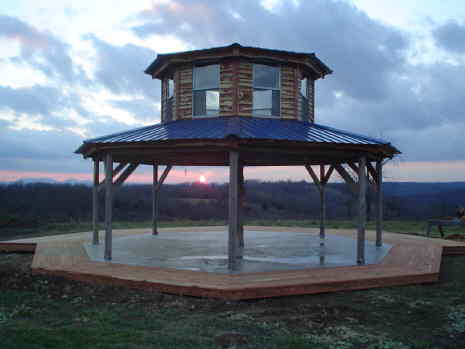Remove pith when sawing boards?
Removing inferior wood from sawlogs. June 24, 2001
Q.
I plan to live saw (or flitch saw) some logs to get wide quartersawn boards. Do I rip the center boards in half to remove the pith? Where do I draw the line when identifying pith?
Forum Responses
Why do you want to remove the pith? The true pith is the size of a pencil--1/4 inch in diameter. However, it may move around quite a bit, especially in crooked logs. Sawing pieces in half (widthwise) will reduce the cupping during drying.
Gene Wengert, forum technical advisor
I consider the first 3-4 rings pretty immature and wouldn't hesitate to lop them off on most woods. More important is the heart shake. If left in the board, it will get pretty ugly. On the other hand, you may get more usable wood if you dry it first and then split it. The board will bow toward the bark when split because of the stresses. If you leave it intact until it is dry, the stresses will counter each other and you may lose less wood when you split it and straighten up the edges. It's many times a flip-of-the-coin call.
From the original questioner:
I assumed the pith and several rings around the pith would be inferior quality compared to more exterior wood. I also thought the small arcs from the tight center rings would cause drying problems. In reading the above responses, I take it that leaving the center boards intact during drying could cause problems (cupping) or could reduce problems (bowing toward the bark). Which is more likely? Is there a chance that full width center boards will dry flat and will never need to be ripped in half? What did you mean when you said it would get pretty ugly? I'm also wondering about the comment regarding the first 3 to 4 rings. Do you mean immediately under the bark? If so, why does anyone make an effort to leave as much wane as they can get away with when sawing for grade? Why not just remove the entire bark edge, making sure not to edge deeper than the first couple of rings?
My experience is:
1. There is a chance that a full width board will dry flat, but ever so slim. That is why I prefer to cut them and flat sawn boards a little meatier than I would a pure quartersawn board. That may give the craftsman a chance to plane the cup out and still have a wide board if he chooses.
2. About getting ugly: When the board begins to dry, the heart shake continues to open up and the edges curl and I've never known if I would have been better off cutting it out or not (talk about an ugly stick). Try to keep the heart shake parallel to the direction of the boards so that only one or two get the full impact of the shake.
*You may have minimal shake. That would be good luck.
3. The first 3 or 4 rings I mentioned are the first ones next to the pith. Their density seems to be quite a bit less than the outer portions of the log and will probably contain quite a few small knots from the twigs when the tree was small.
The above has correctly indicated the problem with pith--warp in drying to the extreme in many cases or else splitting. Incidentally, shake is a separation of the rings parallel to the rings. Drying cracks and splits will go across the rings (when viewed from the end grain).
Gene Wengert, forum technical advisor
Perhaps it's time I update my vocabulary. I was taught that "shake' was synonymous with "split". Heart shake was described to me as that crack that develops in a log, generally at right angles to the bow and/or reaction wood, and that transects the pith. Ring shake and wind shake, I was told, were the same thing and were the separation of spring and summer wood parallel to the rings.
A "shake" was a piece of wood split from a block and was used for anything from shingles to dunnage, depending on its thickness.
It was generally a quartered or vertical grain slab but didn't have to be.
In conversations with people where I live, heart shake isn't a result of drying. Splitting is a result of drying and is referred by many also as a shake. I guess the fact that we communicate and understand what we are talking about doesn't necessarily mean that we are right.
I hate to think of how many years I may have been wrong, but would certainly like to fix it. Got any suggestions of something I could read that wouldn't impart colloquialisms?
Colloquial expressions develop without any help from you or me, so we are stuck with many of them. Most often, the colloquial expression for shake will indicate a fissure defect that is in the living tree. What some people apparently are calling heart shake is more appropriately (in the universal drying language) called a heart check or heart split.
In hardwoods, when grading, the following four cannot be in a cutting--on the surface or in the interior--rot, pith, shake or wane. The NHLA definition is a "separation...between the rings" which means parallel to the rings and not running across them like a drying split or stress crack.
Gene Wengert, forum technical advisor
